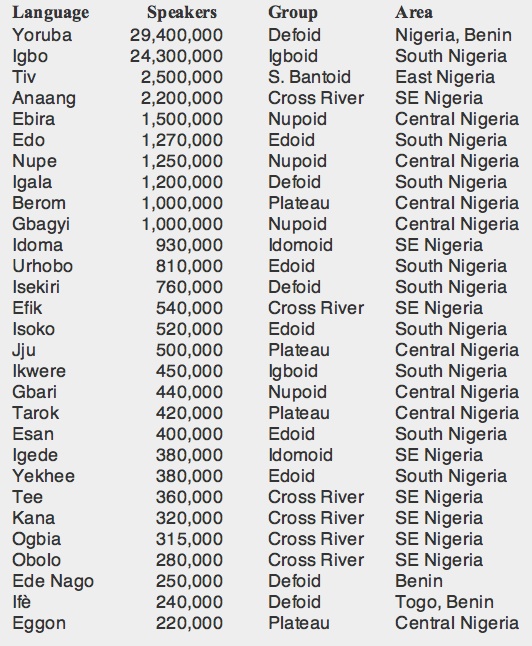An insatiable appetite for ancient and modern tongues


Overview. Benue-Congo, a part of the Niger-Congo phylum, is the largest language family of Africa, including some 900 languages spoken by 500 million people (half of the continent’s population). It is dominant in all central and southern African countries, besides eastern Benin, Nigeria and Cameroon.
External Classification: Niger-Congo, Volta-Congo, Benue-Congo.
Map of Niger-Congo languages (click to enlarge it)
Note: the map depicts the entire Niger-Congo phylum. Benue-Congo is divided into non-Bantoid languages including the language groups (1) to (10) mentioned in the following classification, and Bantoid (group 11) which is itself divided into non-Bantu languages (Bantoid in the map) and Bantu.
Internal Classification: Benue-Congo encompasses about 900 languages divided into Western and Eastern branches, with 11 groups in total. By far, Bantu is the largest group and has the widest territorial extent while the other 10 are restricted to Nigeria and parts of neighboring Benin and Cameroon.
I. Western Benue-Congo
-
(1)Defoid: including Akoko, a dialect cluster of Nigeria, and the Yoruboid subgroup (SW Nigeria and Benin) comprising Yoruba, Igala, Isekiri, Ifè and the Ede complex.
-
(2)Edoid: about 30 languages spoken in southern Nigeria, including Edo, Esan, Yekhee, Isoko and Urhobo.
-
(3)Nupoid: 17 languages spoken in Central Nigeria, including Ebira, Gbari, Gbagyi and Nupe.
-
(4)Idomoid: 9 languages spoken in Central Nigeria, including Idoma and Igede.
-
(5)Igboid: Ekpeye and a subgroup which includes Igbo and Ikwere, spoken in south Nigeria.
-
(6)Isolates: Oko, Ukaan, Akpes. They have small number of speakers living near the confluence of the Niger and Benue rivers in Nigeria.
-
II.Eastern Benue-Congo
-
(7)Kainji: about 60 languages spoken in northern Nigeria by 1 million people in total, including Tsuvadi, Cishingini, Tsishingini and Lela.
-
(8)Jukunoid: a dozen languages, spoken in Nigeria and Cameroon, the most numerous being Wakan with around 150,000 speakers.
-
(9)Plateau: about 40-50 languages spoken by 3.5 million people in the Jos Plateau and surrouding regions of Central Nigeria. The most important are Tarok, Eggon, Che, Berom, Jju, Tyap and Hyam.
-
(10) Cross River (SE Nigeria), divided in:
-
•Upper Cross: Mbembe, Lokaa
-
•Lower Cross: Anaang, Efik, Ibibio, and Obolo
-
•Ogoni: Kana, Tee, Gokana, and Eleme
-
•Central Delta: Ogbia
-
(11)Bantoid, divided in:
-
•Northern Bantoid: small group spoken in eastern Nigeria and western Cameroon.
-
•Southern Bantoid: a very big group including 11 subgroups of which Bantu is the largest.
-
The 10 non-Bantu subgroups comprise more than 100 languages prevalent in eastern Nigeria and Cameroon. Tiv with some 2.5 million speakers is the largest.
-
Bantu languages are spoken all across central and southern Africa by about 330 million people. The main ones are (from north to south): Rwanda, Luba, Nyanja, Shona and Zulu. Swahili is used as a lingua franca in the east coast.
-
Speakers. Around 500 million of which 330 million speak a Bantu language.
Major Benue-Congo Languages (excluding Bantu which figure in the corresponding page).

SHARED FEATURES
-
✦ Phonology
-
-Contrastive nasal vowels and ATR vowel harmony occur in non-Bantu languages.
-
-Labio-velar stops are found in non-Bantu languages.
-
-Bantu languages have prenasalized stops.
-
-A few Bantu (Shona, Nyanja) and non-Bantu languages (Nungu, Kwanja, Tep) have (rare) labial-flaps sounds.
-
-Most Benue-Congo languages have tones which serve to make lexical and/or grammatical distinctions.
-
✦ Morphology
-
-Bantu is a quite homogeneous group showing comparatively little morphological variation among its languages; in contrast non-Bantu languages are much more diverse.
-
-The most distinctive morphological feature of Benue-Congo languages is the grouping of nouns in different classes, marked by prefixes, suffixes or both. Typically, Bantu languages use prefix markers while non-Bantu languages may use also suffixes. All members of a given class share the same affix. Some classes are semantic, others are based on grammatical categories but many are heterogeneous. There is no gender distinction. Some non-Bantu languages (like Jukun and Kana) have lost the noun-class system.
-
-Another distinctive feature of Benue-Congo languages is the system of agreement or concordance between noun modifiers and the noun i.e., they all share the same class prefix. This concord extends also to the verb, and to the subject, object and relative markers.
-
-Verbs often take suffixes, known as verbal extensions, which add causative, reciprocal or separative meaning to the root.
-
-Existence of serial verb constructions in which several verbs, unconnected by conjunctions and having the same tense and mood, stand next to each order. Serial verbs function as a single verb.
-
✦ Syntax
-
-Subject-Verb-Object is the basic order. In most Benue-Congo languages, all noun modifiers follow the head noun. However, in some languages the adjective precedes the noun though the other modifiers follow it.
-
© 2013 Alejandro Gutman and Beatriz Avanzati
Further Reading
-
-The Languages of Africa. J. H. Greenberg. Indiana University Press (1963).
-
-A Linguistic Geography of Africa. B. Heine & D. Nurse. Cambridge University Press (2008).
-
-The Niger-Congo Languages: A Classification and Description of Africa’s Largest Language Family. J.T. Bendor-Samuel & R. L. Hartell (eds). Rowman & Littlefield (1989).
-
-African Language Structures. W. E. Welmers. University of California Press (1973).
Benue-Congo Languages

Address comments and questions to: gutman37@yahoo.com
MAIN LANGUAGE FAMILIES
LANGUAGE AREAS
Languages of Ethiopia & Eritrea
LANGUAGES by COUNTRY
LANGUAGE MAPS
-
• America
-
• Asia
-
Countries & Regions
-
-
Families
-
• Europe
-
• Oceania
